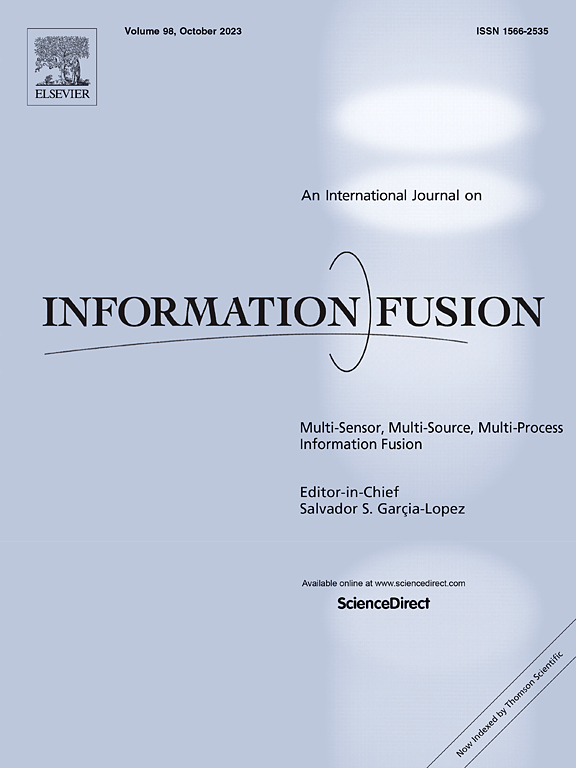PolNet-CR: Spatial-channel collaborative interaction network for PolSAR incremental information-assisted optical satellite imagery cloud removal
IF 15.5
1区 计算机科学
Q1 COMPUTER SCIENCE, ARTIFICIAL INTELLIGENCE
引用次数: 0
Abstract
Reconstruction of missing information in cloud-contaminated optical satellite images is an urgent problem to ensure the continuous spatiotemporal monitoring of Earth’s environment. Despite the recent notable advancements of polarimetric synthetic aperture radar (PolSAR)-fused methods in mitigating the impact of clouds in optical satellite images, challenges remain in recovering high-fidelity cloud-free imagery, which primarily stem from the domain gaps in multimodal imaging mechanisms, the inherent speckle noise in PolSAR imagery, and the inadequate utilization of PolSAR's physical scattering properties, particularly its polarization information. To address these, this paper proposes a novel spatial-channel collaborative interaction network (PolNet-CR), designed to efficiently remove clouds from optical satellite images by incorporating PolSAR data through cross-scale spatial fine-grained aggregation and sparse channel statistical majorization. The network's architecture consists of multiple sequentially stacked information incremental collaboration (IIC) blocks, forming a deep iterative hierarchical framework for more informative cross-domain feature adaptive extraction, interaction, and fusion. Additionally, this paper developed LuojiaSET-PolCR, the first public dataset explicitly incorporating PolSAR polarimetric scattering characteristics for cloud removal in optical imagery, to advance research in this field. Based on this dataset, this paper conducted comparative analyses of PolNet-CR against current representative cloud removal algorithms, employing the “4S” multi-dimensional integrated evaluation system, which assesses spatial, spectral, semantic, and scalability performance. Experimental results demonstrate that PolNet-CR achieves significant improvements in both quantitative metrics and qualitative visual perception, while also meeting the demand for spatiotemporal cloud-free imagery in seamless continuous observation applications. The project is publicly available at: https://github.com/RSIIPAC/PolNet-CR.
PolNet-CR:用于PolSAR增量信息辅助光学卫星图像云去除的空间通道协同交互网络
云污染光学卫星图像中缺失信息的重建是保证地球环境连续时空监测的迫切问题。尽管近年来偏振合成孔径雷达(PolSAR)融合方法在减轻光学卫星图像中云的影响方面取得了显著进展,但在恢复高保真无云图像方面仍然存在挑战,这主要源于多模态成像机制中的域间隙、PolSAR图像中固有的散斑噪声以及PolSAR物理散射特性(特别是其偏振信息)的利用不足。为了解决这些问题,本文提出了一种新的空间通道协同交互网络(PolNet-CR),旨在通过跨尺度的空间细粒度聚合和稀疏通道统计化来整合PolSAR数据,从而有效地从光学卫星图像中去除云。该网络架构由多个顺序堆叠的信息增量协作(information incremental collaboration, IIC)块组成,形成了一个深度迭代的层次结构框架,用于更多信息的跨域特征自适应提取、交互和融合。此外,本文还开发了首个明确纳入PolSAR偏振散射特征的公共数据集“珞家aset - polcr”,用于光学图像中云的去除,从而推动了该领域的研究。基于该数据集,本文采用“4S”多维综合评价体系,从空间、频谱、语义和可扩展性四个方面对PolNet-CR与当前具有代表性的去云算法进行了对比分析。实验结果表明,PolNet-CR在定量指标和定性视觉感知方面都取得了显著的改进,同时也满足了无缝连续观测应用中对时空无云图像的需求。该项目可在:https://github.com/RSIIPAC/PolNet-CR上公开获取。
本文章由计算机程序翻译,如有差异,请以英文原文为准。
求助全文
约1分钟内获得全文
求助全文
来源期刊

Information Fusion
工程技术-计算机:理论方法
CiteScore
33.20
自引率
4.30%
发文量
161
审稿时长
7.9 months
期刊介绍:
Information Fusion serves as a central platform for showcasing advancements in multi-sensor, multi-source, multi-process information fusion, fostering collaboration among diverse disciplines driving its progress. It is the leading outlet for sharing research and development in this field, focusing on architectures, algorithms, and applications. Papers dealing with fundamental theoretical analyses as well as those demonstrating their application to real-world problems will be welcome.
 求助内容:
求助内容: 应助结果提醒方式:
应助结果提醒方式:


